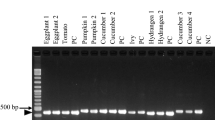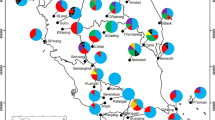Abstract
A well-established population of Claviceps purpurea var. spartinae R.A. Duncan & J.F. White was found on the invasive common cord-grass Spartina anglica C.E. Hubbard at two localities on the German North Sea coast. Additionally, 25 populations of S. anglica with an average air-line distance of 50 km between them along the coastline, starting from the Netherlands via the German coastline up to Denmark, were investigated. All S. anglica populations were heavily infected with C. purpurea var. spartinae (lineage G3). Genetic characterization of the C. purpurea DNA using Amplified Fragment Length Polymorphism (AFLP) and Internal Transcribed Spacer (ITS) analysis clearly indicated that all populations collected at the Wadden Sea were grouped in the same epidemic clade. Comparisons with reference strains indicated that the isolates along the Wadden Sea belonged to the clade also found in Ireland and Wales. The ergot alkaloid pattern is very similar in all genotypes. Ergocristine, α-ergocryptine and their epimers were identified in the samples in high amounts comparable to average values in sclerotia found on rye. The sclerotia of C. purpurea var. spartinae are able to float on the water for several months and could thereby be distributed over large distances by seawater. The sclerotia found in the drift lines still contain the equally high contents of ergot alkaloids as those collected directly from the plants. Current data form the basis for risk assessments and predictions about further spreading of C. purpurea var. spartinae on S. anglica.






Similar content being viewed by others
References
Adsersen, H., Randløv, M. S., Nielsson, N., Larsen, R. S., Francke, M. S., & Boesgaard, K. (2010). Invasion history of Spartina anglica in Denmark. Svensk Botanisk Tidskrift, 104(6), 393–404.
Agrios, G. N. (2005). Plant Pathology. Waltham: Academic.
Bakker, L., van der Wal, R., Esselink, P., & Siepel, A. (1999). Exploitation of a new staging area in the Dutch Wadden Sea by Greylag Geese Anser anser: the importance of food-plant dynamics. Ardea, 87(1), 1–13.
Blaney, B. J., Molloy, J. B., & Brock, I. J. (2009). Alkaloids in Australian rye ergot (Claviceps purpurea) sclerotia: implications for food and stockfeed regulations. Animal Production Science, 49, 975–982.
Dice, L. R. (1945). Measures of the amount of ecologic association between species. Ecology, 26, 297–302.
Douhan, G. W., Smith, M. E., Huyrn, K. L., Westbrook, A., Beerli, P., & Fisher, A. J. (2008). Multigene analysis suggests ecological speciation in the fungal pathogen Claviceps purpurea. Molecular Ecology, 17(9), 2276–2286.
Duncan, R. A., Sullivan, R., Alderman, S. C., Spatafora, J. W., & White, J. F. (2002). Claviceps purpurea var. spartinae var. nov.: An ergot adapted to the aquatic environment. Mycotaxon, 81, 11–25.
Eleuterius, L. N., & Meyers, S. P. (1977). Alkaloids of Claviceps from Spartina. Mycologia, 69(4), 838–840.
Engeland, I. V., Andresen, O., Ropstad, H., Kindahl, H., Waldeland, A., Daskin, A., & Eik, L. O. (1998). Effect of fungal alkaloids on the development of pregnancy and endocrine foetal-placental function in the goat. Animal Reproduction Science, 52(4), 289–302.
European Food Safety Authority. (2005). Opinion of the scientific panel on contaminants in food chain on a request from the commission related to ergot as undesirable substance in animal feed. The EFSA Journal, 225, 1–27.
Fisher, A. J., DiTomaso, J. M., & Gordon, T. R. (2005). Intraspecific groups of Claviceps purpurea associated with grass species in Willapa Bay, Washington, and the prospects for biological control of invasive Spartina alterniflora. Biological Control, 34(2), 170–179.
Gardes, M., & Brunes, T. D. (1993). ITS primers with enhanced specificity for Basidiomycetes – application to the identification of mycorrhiza and rusts. Molecular Ecology, 2, 113–118.
Hampl, V., Pavlicek, A., & Flegr, J. (2001). Construction and bootstrap analysis of DNA fingerprinting based phylogenetic trees with the freeware program FreeTree: application to Trichomonad parasites. International Journal of Systematic and Evolutionary Microbiology, 51, 731–735.
Komarova, E. L., & Tolkachev, O. N. (2001). The chemistry of peptide ergot alkaloids. Part 1. Classification and chemistry of ergot peptides. Pharmaceutical Chemistry Journal, 35(9), 504–513.
Krska, R., Stubbings, G., MacArthur, R., & Crews, C. (2008). Simultaneous determination of six major ergot alkaloids and their epimers in cereals and foodstuffs by LC-MS-MS. Analytical and Bioanalytical Chemistry, 391, 563–576.
Mainka, S., Danicke, S., Bohme, H., Überschar, K. H., & Liebert, F. (2007). On the composition of ergot and the effects of feeding two different ergot sources on piglets. Animal Feed Science and Technology, 139, 52–68.
Mulac, D., & Humpf, H. U. (2011). Cytotoxicity and accumulation of ergot alkaloids in human primary cells. Toxicology, 282, 112–121.
Müller, C., Kemmlein, S., Klaffke, H., Krauthause, W., Preiss-Weigert, A., & Wittkowski, R. (2009). A basic tool for risk assessment: a new method for the analysis of ergot alkaloids in rye and selected rye products. Molecular Nutrition and Food Research, 53(4), 500–507.
Nehring, S., & Hesse, K. J. (2008). Invasive alien plants in marine protected areas: the Spartina anglica affair in the European Wadden Sea. Biological Invasions, 10, 937–950.
Nehring, S., Boestfleisch, C., Buhmann, A., & Papenbrock, J. (2012). The North American toxic fungal pathogen G3 Claviceps purpurea (Fries) Tulasne is established in the German Wadden Sea. BioInvasions Records, 1, 5–10.
Nei, M., & Li, W. H. (1979). Mathematical model for studying genetic variation in terms of restriction endonucleases. Proceedings of the National Academy of Sciences of the United States of America, 76(10), 5269–5273.
Nelson, E. C. (2000). Sea beans and nickar nuts. A handbook of exotic seeds and fruits stranded on beaches in north-western Europe. London: BSBI Handbook.
Oresanya, T. F., Patience, J. F., Zijistra, R. T., Beaulieu, A. D., Middleton, D. M., Blakley, B. R., & Gillis, D. A. (2003). Defining the tolerable level of ergot in the diet of weaned pigs. Canadian Journal of Animal Science, 83(3), 493–500.
Otto, L., & van Aken, H. M. (1996). Surface circulation in the northeast Atlantic as observed with drifters. Deep-sea research Part I, Oceanographic research papers, 43(4), 467–499.
Pažoutová, S. (2002). Evolutionary strategy of Claviceps. In J. F. White, C. W. Bacon, & N. L. Hywel-Jones (Eds.), Clavicipitalean Fungi: Evolutionary Biology, Chemistry, Biocontrol and Cultural Impacts (pp. 329–354). New York: Marcel Dekker.
Pažoutová, S., Olšovská, J., Linka, M., Kolínská, R., & Flieger, M. (2000). Chemoraces and habitat specialization of Claviceps purpurea populations. Applied and Environmental Microbiology, 66(12), 5419–5425.
Pažoutová, S., Raybould, A. F., Honzátko, A., & Kolínská, R. (2002). Specialized populations of Claviceps purpurea from salt marsh Spartina species. Mycological Research, 106, 210–214.
Rohlf, F. J. (2005). NTSYSpc: Numerical Taxonomy System, ver. 2.11X. Setauket: Exeter Publishing, Ltd.
Scott, P. M. (2009). Ergot alkaloids: extent of human and animal exposure. World Mycotoxin Journal, 2(2), 141–149.
Smith, D. J., & Shappell, N. W. (2002). Technical note: epimerization of ergopeptine alkaloids in organic and aqueous solvents. Journal of Animal Science, 80(6), 1616–1622.
Strickland, J. R., Looper, M. L., Matthews, J. C., Rosenkrans, C. F., Jr., Flythe, M. D., & Brown, K. R. (2011). Board-invited review: St. Anthony’s Fire in livestock: causes, mechanisms, and potential solutions. Journal of Animal Science, 89(5), 1603–1626.
Tamura, K., Peterson, D., Peterson, N., Stecher, G., Nei, M., & Kumar, S. (2011). MEGA5: molecular evolutionary genetics analysis using maximum likelihood, evolutionary distance, and maximum parsimony methods. Molecular Biology and Evolution, 28(10), 2731–2739.
Thompson, J. D. (1991). The biology of an invasive plant. What makes Spartina anglica so successful? Bioscience, 41(6), 393–401.
Uhlig, S., Vikoren, T., Ivanova, L., & Handeland, K. (2007). Ergot alkaloids in Norwegian wild grasses: a mass spectrometric approach. Rapid Communications in Mass Spectrometry, 21(10), 1651–1660.
Vos, P., Hogers, R., Bleeker, M., Reijans, M., Van de Lee, T., Hornes, M., Frijters, A., Pot, J., Peleman, J., Kuiper, M., & Zabeau, M. (1995). AFLP: a new technique for DNA fingerprinting. Nucleic Acids Research, 23(21), 4407–4414.
White, T. J., Bruns, T., Lee, S., & Taylor, J. W. (1990). Amplification and direct sequencing of fungal ribosomal RNA genes for phylogenetics. In M. A. Innis, D. H. Gelfand, J. J. Sninsky, & T. J. White (Eds.), PCR Protocols: A Guide to Methods and Applications (pp. 315–322). New York: Academic.
Acknowledgments
We greatly acknowledge Mrs. Anne Buhmann and Mrs. Yvonne Leye for initial sampling and Mrs. Jutta Barras-Akhnoukh for technical assistance in toxin analysis. We would like to thank Nationalparkverwaltung Niedersächsisches Wattenmeer and Landesbetrieb für Küstenschutz, Nationalpark und Meeresschutz, Schleswig-Holstein, Germany, for the permission to take samples. We would also like to acknowledge the Naturschutzbund Deutschland e.V. (NABU), especially the NABU Stations in Wangerooge, Borkum and Westerspätinge for cooperation. We are grateful to Prof. Dr. R. Cox, Hannover, Germany, for correcting the English language and Dr. M. Kolarik, Prague, Czech Republic, for valuable suggestions concerning the taxonomy of C. purpurea.
Culture deposition
Claviceps purpurea var. spartinae isolate from Caeciliengroden is available under serial number DSM 26190 at the Leibniz-Institut DSMZ, Deutsche Sammlung von Mikroorganismen und Zellkulturen GmbH, Inhoffenstraße 7B, D-38124 Braunschweig, Germany.
Author information
Authors and Affiliations
Corresponding author
Additional information
Sylvie Pažoutová sadly passed away on 6 September 2013.
Electronic supplementary material
Below is the link to the electronic supplementary material.
ESM 1
(DOCX 14 kb)
Rights and permissions
About this article
Cite this article
Boestfleisch, C., Drotleff, A.M., Ternes, W. et al. The invasive ergot Claviceps purpurea var. spartinae recently established in the European Wadden Sea on common cord grass is genetically homogeneous and the sclerotia contain high amounts of ergot alkaloids. Eur J Plant Pathol 141, 445–461 (2015). https://doi.org/10.1007/s10658-014-0555-x
Accepted:
Published:
Issue Date:
DOI: https://doi.org/10.1007/s10658-014-0555-x




